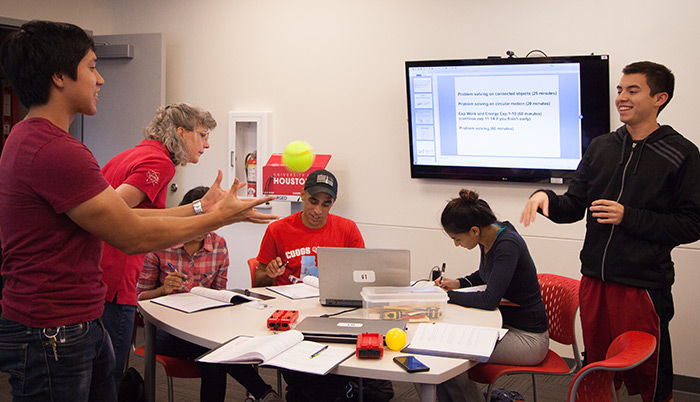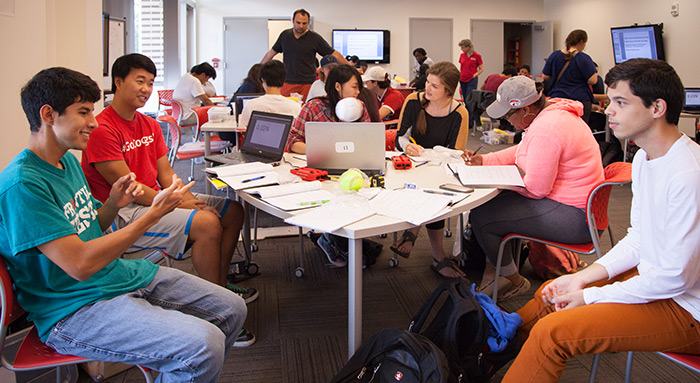
Learning by Doing: Inquiry-Based Physics Course for Student Success
Activities Help Students Gain Physical Intuition of Concepts
New inquiry-based sections of two introductory physics courses are being piloted at the University of Houston, as part of the Department of Physics’ ongoing commitment to improving student success.
The pilot project includes one section of PHYS 1301, the algebra-based physics course that is a requirement for many science majors, and a section of PHYS 1321, the calculus-based physics course required for many engineering majors.
 In this inquiry-based course, students learn by participating in activities that reinforce physics concepts.The students enrolled in these pilot classes complete all of the homework, quizzes and tests that are required for students in the non-pilot versions of the course. The only difference being the method of learning. In these inquiry-based courses, students learn by participating in activities that reinforce physics concepts.
In this inquiry-based course, students learn by participating in activities that reinforce physics concepts.The students enrolled in these pilot classes complete all of the homework, quizzes and tests that are required for students in the non-pilot versions of the course. The only difference being the method of learning. In these inquiry-based courses, students learn by participating in activities that reinforce physics concepts.
“Instead of a professor standing in front of a class, lecturing that the formula for kinetic energy is ½ mv2, students will be throwing a ball,” said Rebecca Forrest, instructional associate professor of physics, and one of the co-developers of the PHYS 1301 course. “They’re going to be throwing it fast and slow, and they’ll be throwing one with less mass and one with more mass. They’re going to feel the energy and work associated with throwing and catching that ball.”
Inquiry-Based Learning Promotes Learning and Retention of Ideas
Inquiry-based learning works by presenting students with tangible questions, situations or observations, rather than presenting concepts as established facts. This process, which promotes the active engagement of students, has been shown to result in the increased learning and retention of ideas.
“Physics is not a required course in high school. If students haven’t been exposed to physics concepts before, physics is going to be harder for them,” said Margaret Cheung, associate professor of physics and co-developer of the course. “We see many of these students struggling, not because of a lack of motivation, but because of a lack of background knowledge.”

“In these courses, students learn by doing hands-on, inquiry-based activities,” Forrest said. “They are developing a physical intuition of the concepts.”
Once these sections have been piloted and the student outcomes analyzed, the physics department hopes to offer multiple sections for each course.
Development of these physics pilot courses is part of the College of Natural Sciences and Mathematics’ ongoing commitment to promoting student success by expanding the diversity and quality of course offerings.
“We need to credit the chair of the physics department, Gemunu Gunaratne, for his commitment to improving the college experience for undergraduate students,” Cheung said.
Rachel Fairbank, College of Natural Sciences and Mathematics